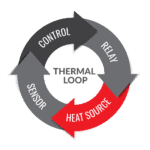*Note – This is the third article in a series on the thermal loop. See the bottom of this article for all posts in this series.
What is a PID Controller?
In previous articles in our series covering the thermal loop, we mentioned that there are 3 main types of temperature control: On Off, Proportional and PID control. Today, we intend to go a little deeper into PID Temperature control and how it can help you decide the best way to control your temperature system. PID control loop is the most accurate of all types of thermal loop controllers. First, let’s define what PID means: Proportional Integral Derivative.
What does PID stand for?
P = Proportional: as discussed above, a PID controller has the same feature allowing it to begin to proportion the controller output before and after the setpoint.
I = Integral: a factor that works along with the derivative function to correct any underperformance resulting from the proportional function. In ovens or chiller systems, as the controller tries to keep the system from overshooting the setpoint, the integral function is a factor applied to that specific system to help it get up to temperature. Integral helps to create a much more accurate system, and can be a different value for every single application.
D = Derivative: kind of works like breaks on a car. The derivative function’s purpose is to help eliminate or minimize to a high degree the overshoot of the process temperature.
How does a PID Controller work?
PID controllers are designed to work in more highly precise control scenarios. Temperature controllers with this method of controlling the desired output are looking at many other variables vs. on off or proportional control. PID Temp controllers not only monitor where the temperature is vs the process variable or set point, but they also control the ramp rate, output percentage as well as monitor for overshoot. All of this is done within a small on board microprocessor.
Most PID Temp controllers have a process called “Autotune” that allows a PID controller to “learn” it’s specific system. One using the autotune process would typically energize their system with the controller PID settings set to factory default. Let’s say for example you have a process that needs to maintain 350 F. When the autotune feature is initiated, and once the system has reached the 350F set point, the controller would then initiate the autotune process. Once initiated, the controller would drop the temperature about 50F to say 300F.. Then the system would apply heat to get back up to the original set point. It may do this 2-3 times before it learns what P, I, and D settings to apply. Now the controller can see how fast the system can gain and lose heat. This helps it to revise the factory default settings to more appropriate levels that are specific to this application. The controller has learned for this application how to correctly control and maintain temperatures, which translates into a more accurate demand of percentage output to the relay and thermal system.This is very helpful in creating a PID controller that is accurate and useful. It also creates a system that is much more efficient.
Power Control is critical when using PID Temperature Controllers
This PID controller can make very rapid requests in demand for output than older on off or proportional control methods. Utilizing a relay or power controller that can react to these demand changes is critical. Old relays or motor starters can’t “act” fast enough.
PID controllers produce a demand output in the form of 0-100%. This output can change multiple times in one second depending on how often the controller samples the sensor input.
Only solid state relays (SSR’s) or silicon controlled rectifiers (SCR’s) have the ability to react fast enough to proportion power to the thermal source. We will cover that topic in more detail in a future blog post.
PID Controllers are best for precise temperature control
PID control as stated above is fantastic for ovens requiring precise cooking or curing temperatures over time. Small platen presses will often require consistent curing temperatures as well. Additionally, PID controllers are almost exclusively used for small gas streams that are sensitive to even the slightest temperature change.
Are you using PID controllers in your process heating plan? This could be a great potential upgrade if you feel that you need a more precise and efficient temperature control system. Our engineers at Powerblanket are ready to help you find the exact heating solutions your business needs. Reach out to us to establish a heat plan that’s efficient and brings you peace of mind.
The Thermal Loop Series
2- What is a Temperature Controller and How Does It Work?
4- On/Off Controls and the Thermal Loop
5- Proportional Control in the Thermal Loop
6- Temperature Sensors and Perfect Placement
Powerblanket's industrial control solutions give you the power to automate, remotely control, and monitor your valuable materials and equipment.




